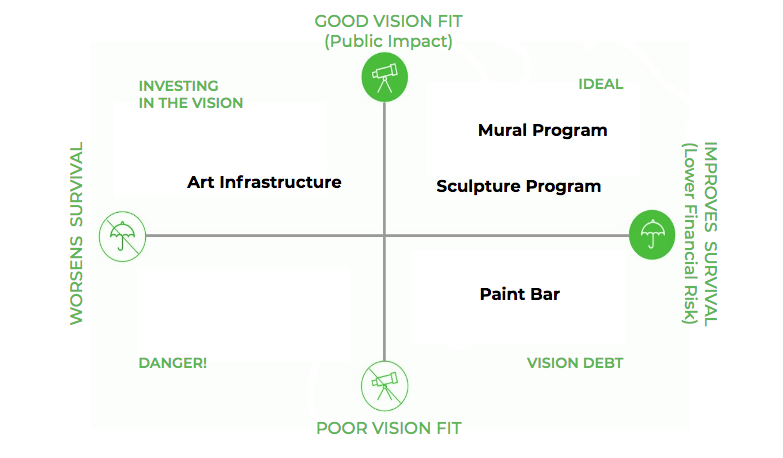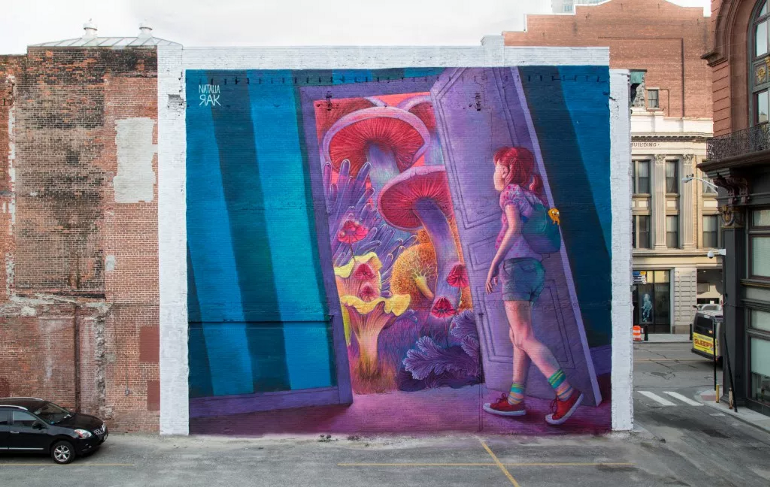As you and your team build your product, you have forces pulling you in different directions. Your customers may be demanding a feature urgently while your investors want you to hurry up on delivering a different feature to grow revenues. In the reality of these short-term needs, it’s easy for your everyday actions to feel disconnected from your vision.
A good vision gives you a clear purpose and direction – it’s like having a powerful engine on a car. Prioritization is like the tires – it’s where your vision meets the reality on the ground (your business needs).
The Radical Product Thinking approach to prioritization gives you a simple rubric to help you balance making progress towards the vision against the reality of day-to-day needs. In this article, I’ll share the example of how The Avenue Concept, a non-profit in public art, used this rubric to evaluate priorities and communicate them to the the team and the board.
 Prioritization is like the tires on a car: it’s where your vision meets reality
Prioritization is like the tires on a car: it’s where your vision meets reality
Background
The Avenue Concept (TAC) is a non-profit with the mission of creating a deep societal impact by bringing art into public awareness. The organization, and specifically their Executive Director, Yarrow Thorne, had accomplished a series of major installations of public art.
Over time, as there was increasing awareness of TAC’s ability to complete public art installations quickly, other organizations and even individuals began to engage TAC on new projects. Rather than stretching itself across too many projects, the TAC team decided to develop a three-year strategic plan to prioritize opportunities that would maximize its impact.
We applied Radical Product thinking to establish evaluation criteria that the board and team could use on a regular basis to prioritize new opportunities as they continued to pop up.
The Radical Product Thinking rubric for prioritization
Using this tool required creating alignment on the following:
- Vision: The Avenue Concept already had a clear vision of creating deep social impact by bringing art into public awareness.
- Survival: Survival refers to mitigating the biggest risks that could shut you down tomorrow. For The Avenue Concept, as for many non-profits or startups, Survival was defined as continued access to funding.
 TAC’s Prioritization Rubric
TAC’s Prioritization Rubric
With Vision and Survival defined, we evaluated and plotted opportunities into quadrants:
-
Ideal: Items in the top right quadrant are both a good vision fit and help the organization survive — a strategy with lots of these items is likely to be a promising one. For TAC, the Sculpture and Mural Programs were good vision fits — they were very visible and therefore raised awareness of public art. They fit in the Ideal quadrant because Thorne had also figured out how to scalably source and install artworks. But focusing only on opportunities in the Ideal quadrant would have been myopic.
-
Investing in the Vision: To deliver progressively on the long-term vision, you need to periodically invest in the vision. For TAC, the Art Infrastructure program, which included installing lighting to highlight installations in the evenings, was an investment in the vision. The infrastructure would enhance the appearance of artworks and help build awareness of public art, but installation was resource-intensive. TAC had to pick selectively from this quadrant.
-
Vision Debt: Sometimes to invest in the vision, you may need to take on projects that bring in revenue, but may be a poor vision fit; pursuing them results in “vision debt”. For TAC, the Paint Bar (its studio and supplies store for local artists) was an example of using vision debt wisely. While the studio didn’t create a deep and meaningful impact through public art, it made creating murals more sustainable and promoted engagement with local artists. TAC was careful in taking on Vision Debt knowing that incurring too much would derail what TAC stood for.
-
Danger!: Items in the bottom left are both a poor vision fit and expose you to additional risk. Only pursue items here if they unlock important opportunities in the future. TAC didn’t have opportunities in this quadrant.
Using this approach in your organization
This approach to prioritization is an easy way to bring Radical Product thinking into your organization. Teams at any level can use this, whether it’s the executive leadership team or a product development team.
Start by crafting your Vision and Survival statements using the free Radical Product toolkit. In a large organization, each product team should craft its definition of product Vision and Survival. You can then draw up the 2x2 rubric of Vision Fit vs. Survival on a whiteboard, and the team can move Post-its to different quadrants when discussing how to prioritize features or initiatives.
As you discuss your rationale for decision-making and trade-offs using this approach, you’ll get more buy-in from your team. Further, by giving your team tools to evaluate opportunities the way you do, the decisions made when you cannot be present are more likely to be aligned with your collective goals.
The RPT approach to prioritization helps you translate a good vision into priorities — it gives your vision traction when it meets the reality on the ground.
